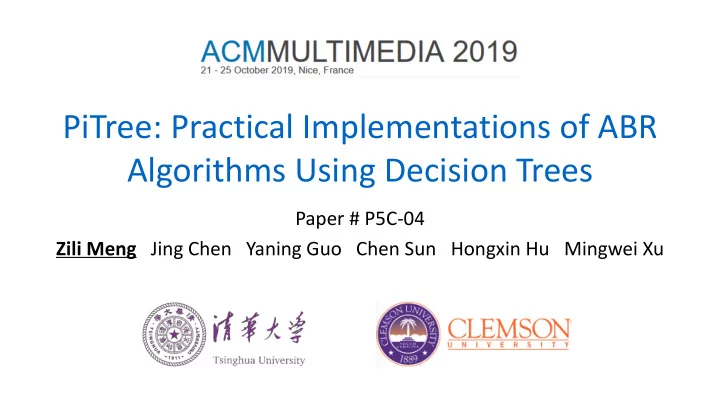

PiTree: Practical Implementations of ABR Algorithms Using Decision Trees Paper # P5C-04 Zili Meng Jing Chen Yaning Guo Chen Sun Hongxin Hu Mingwei Xu
Adaptive Bitrate (ABR) Algorithms Client Video server Quality Quality Bandwidth ABR High Medium Low Time Time Time Partially borrowed from “Neural Adaptive Content - aware Internet Video Delivery” in USENIX NSDI 2018. 2 https://transys.io/pitree P5C-04
Adaptive Bitrate (ABR) Algorithms Deep Neural Networks Learning Deeper NNs Complex Linear Programming Optimization Hidden Markov Model Harmonic Mean (Rate) Explicit Piecewise Linear (Buffer) Formula 2011 2012 2013 2014 2015 2016 2017 2018 2019 3 https://transys.io/pitree P5C-04
Drawbacks – Heavyweight Client-side Implementation Server-side Implementation • Large page size. • High operating expenses. – Pensieve [SIGCOMM’17] increased HTML – Up to millions of concurrent viewers. page size by 4x. – Page load time is increased by ~ 10s. • Long decision latency. – RobustMPC [SIGCOMM’15] increased decision latency to seconds. – Decision latency > chunk length. R = RobustMPC [SIGCOMM’15]: ILP P = Pensieve [SIGCOMM’17]: DNN H = HotDASH [ICNP’18]: 2xDNN https://transys.io/pitree P5C-04 4
Our Contribution: PiTree • Design & train ABR algorithms offline as usual. • Convert the model into a decision tree. Decision tree • Deploy the decision tree online. Offline training/design Online deployment Sophisticated ABR model network traces (e.g., DNN, ILP) decisions https://transys.io/pitree P5C-04 5
Design Choice: Why Decision Tree? • Non-parametric and internal nodes expressive. low local approximation leaf nodes 𝑇 2 error decision state boundary space 𝑇 1 https://transys.io/pitree P5C-04 6
Design Choice: Why Decision Tree? • Non-parametric and A decision tree with 100 leaf nodes: expressive. Page size increase <1% • Lightweight for video Decision latency <1ms players. smartphone laptop https://transys.io/pitree P5C-04 7
Design Choice: Why Decision Tree? • Non-parametric and expressive. • Lightweight for video players. • Following the decision logic of ABR algorithms. Decision tree of BBA [SIGCOMM’14] . https://transys.io/pitree P5C-04 8
Design Challenge: Sequential Dependency • ABR Control is a sequential decision-making process. bandwidth logs chunk ABR Internet HTTP Controller request bitrate Buffer buffer occupancy https://transys.io/pitree P5C-04 9
Design Challenge: Sequential Dependency • ABR Control is a sequential unexperienced decision-making process. state space prediction error • One wrong prediction may drive the student off teacher’s trajectory. teacher student https://transys.io/pitree P5C-04 10
PiTree: Imitation Learning – Follow the Leader (in)correct actions traffic traces states teacher.predict() virtual player videos add into train add into retrain correct decision tree (s,a) set actions deploy onto video clients https://transys.io/pitree P5C-04 11
For design details and theoretical analysis, please refer to our paper.
Evaluation – Quality of Experience (QoE) Ratio • Summary of experiments Pensieve 100% HotDASH – 3 QoE metrics. RobustMPC – 3 sets of bandwidth traces. 75% – 3 ABR algorithms. 98% CDF 50% QoE PiTree • QoE ratio = QoE Original 25% • Average QoE ratio > 97%. 0% • Median QoE ratio > 98%. 90% 95% 100% 105% 110% • Details in the paper. QoE Ratio 13 https://transys.io/pitree P5C-04
Evaluation – Page Size 2500 5.8x 2000 Page Size (KB) 4.6x 1500 14.5s @ 1Mbps 1000 0.6% 1.4% 1.2% 3.1% 500 0 Our experiments: RobustMPC [SIGCOMM’15]: ILP Pensieve [SIGCOMM’17]: DNN <0.1s @ 1Mbps HotDASH [ICNP’18]: 2xDNN https://transys.io/pitree P5C-04 14
Evaluation – Latency 10s PC Mobile ~ 4s 1s 0.1s 10ms 1ms 1ms Intel Core i7-8550 0.1ms 10μs RobustMPC [SIGCOMM’15]: ILP Pensieve [SIGCOMM’17]: DNN Qualcomm Snapdragon 821 HotDASH [ICNP’18]: 2xDNN https://transys.io/pitree P5C-04 15
Takeaways • Current ABR algorithms are increasingly heavyweight. • PiTree convert complex ABR algorithms to decision trees to deploy them in a lightweight way. – Use imitation learning to address the action dependency. • PiTree can significantly reduce the algorithm overhead with negligible QoE loss. – Page size reduced by up to 5x, decision latency reduced by up to 1000x. 16 https://transys.io/pitree P5C-04
Thank you! Questions and comments? Try your ABR algorithms with PiTree! https://transys.io/pitree zilim@ieee.org
Recommend
More recommend